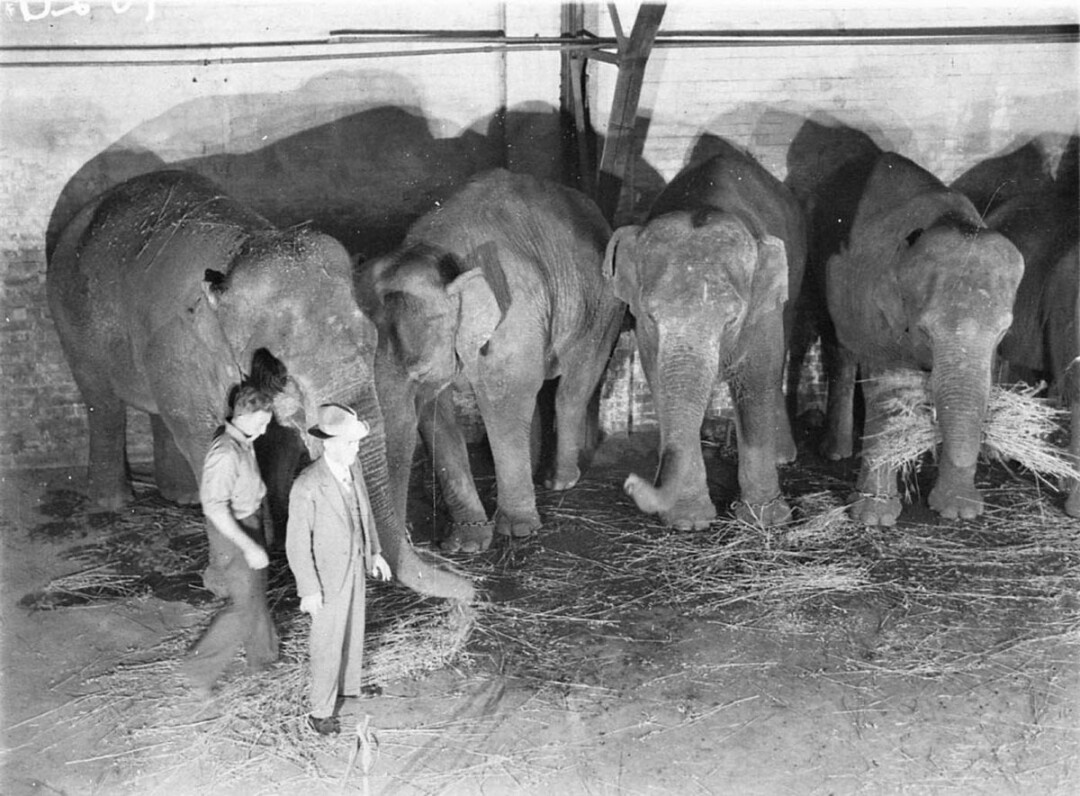Eau Claire's Elephant Tale
the heartbreaking and mysterious story of a circus performer laid to rest during a long-ago summer

Riddled with rumor, exaggeration, speculation, and maybe even a few ghost stories, local accounts of what has come to be called the “Eastside Hill Elephant” are based on a true story that took place long ago in Eau Claire when the circus came to town.
After arriving before dawn on the hot and sticky morning of June 28, 1901, roustabouts for the B.E. Wallace Circus set about erecting the show’s claimed 10 acres of canvas tent on the east edge of what we now call the Third Ward. However, they had only raised the “menagerie tent” when at about 8am, with little warning, a fierce electrical storm rolled in with high winds, soaking rain, and artillery-like thunder and lightning strikes.
Crammed with animals, bystanders and circus workers, the tent was walloped by a ferocious blast – the high voltage surge possibly attracted to the heavy iron chains linking the show’s five elephants. According to the Eau Claire Leader, an onlooker said, “There was a flash and a crash and the bolt knocked down the elephants. Ella was the first to get up, but then she fell over, dead.” One trainer suggested Ella, the show’s most famous performer, had “died of fright.” Miraculously no circus workers or bystanders were injured, though a boy and the hay bale he had been sitting on were blown clear out of the tent.
As the rain continued to fall, the four surviving elephants struggled to pull off a wet canvas that had been laid over Ella, gently prodded her with their trunks and offered her bundles of hay. It was reported that each mourning beast was given a “big dose of whiskey,” with two quarts for the Gyp, the largest survivor.
Said to be “the best trick elephant in the business,” Ella, the “Bicycle Riding Pachyderm,” had been valued at $10,000 (about $300,000 today). Even the New York Times ran a story of Ella’s demise a few days later. Despite the loss, the circus parade took place that afternoon under clearing skies, and shows went on Friday and Saturday before the circus had to pack up on Sunday for its next stop in Stillwater, Minnesota.
But what do you do with a dead elephant? According to The Rivers Flow On, Lois Barland’s compendium of Eau Claire history, Ella was buried near what is now the corner of Roosevelt Avenue and Garfield Avenue, though not until her feet had allegedly been removed, some say either to be served at a big city restaurant or for snake oil medicine.
One year later, contractors were grading a new race track for the Eau Claire Driving Park, and the corpse was unearthed. “The stench that enveloped that section of the Third Ward was offensive and the cause of strong protest by the residents,” the Leader reported.The remains were then exhumed and reburied in a woodsy area on the East Hill and forgotten. Some theorized Ella’s final resting place was at the foot of what some call “The Elephant Tree” at the corner of Badger Avenue and Margaret Street, but the exact location was only a guess until excavation to enlarge the basement of a home at 1610 Hogeboom St. revealed bones “too large to have come from any animal inhabiting Wisconsin,” the Leader reported at the time. Experts identified the bones as those of an elephant. Where the bones went after that is unclear.
Ella’s death wasn’t the last catastrophe for the B.E. Wallace Show. After merging in 1908 with the equally popular Carl Hagenbeck Circus (the first to use “rewards-based training”), eight of its elephants, 21 lions and tigers, and eight performing horses were lost in the Great Flood of 1913. Tragically, the circus train was destroyed in the famous Hammond Train Wreck and Fire of 1918 when it was rear-ended by a troop train whose engineer had fallen asleep, resulting in 84 human fatalities. The crash marked the beginning of the steady decline of all the great circuses and became the subject of Roustabout: The Great Circus Train Wreck! – a play produced in 2016 at UW-Eau Claire under the direction of theatre faculty member Arthur Grothe, closing the loop of Eau Claire’s illustrious connection with the glory days of the world’s largest traveling circuses.
This ad for the B.E. Wallace Circus, which was published in The Daily Telegram newspaper on June 27, 1901, features Ella the Elephant riding her tricycle ...



















